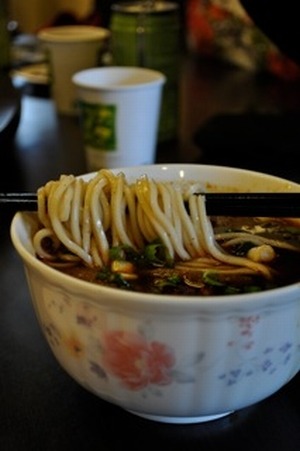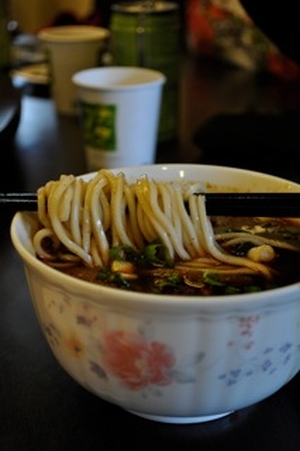Discovering Taiwan's Best Eats
This year, Taiwan's centennial thrust the large island off the southeast coast of China back into the spotlight. Better known for its rocky political history — Taiwan occupies 99 percent of the land affiliated with Chiang Kai-shek's Republic of China, the opposing party to the mainland People's Republic of China — Taiwan has oft been overlooked as the peaceful Asian retreat that it actually is. Long known as Formosa, which means "beautiful island," this 250-mile stretch of land is a mix of bustling cityscapes and tranquil meadows, expansive lakes and sweeping gorges, and mountainous plains and sandy beaches. As you make your way through Asia, take time for a weekend stopover in this small slice of the Pacific. There's plenty to do, and more importantly, there's plenty to eat. Make no mistake — Taiwan is certifiably a food capital of the east.
Friday
First things first: food. Head over to the bi-level Lao Zhang Beef Restaurant for your introductory Taiwanese meal. This noodle soup shop is ground zero for slurping an assortment of stewed beef and
lawei niurou mian, or spicy-flavored soup.
After lunch, make your way down to Taipei's Xinyi business district. If you get lost along the way, just look up and locate Taipei 101, the second tallest building in the world (Dubai's Burj Khalifa stole the title in 2010), and a symbol of Taiwan's steady economy. Claiming a height of 500 meters, the tower sits 101 stories above the ground, boasts the world's fastest elevators, and indoor/outdoor observatory decks for a 360-degree view of the city. More impressive, in July 2011, the building was awarded LEED (Leadership in Energy and Environmental Design) Platinum certification, becoming the tallest LEED building in the world.
If shopping's your bag, the Xinyi District houses a cluster of malls and shopping centers like the upscale Taipei 101 Mall, the nine-story Bellavita, and Japanese Shin Kong Mitsukoshi department stores, while for the literary-inclined, popular Eslite bookstore is open 24 hours a day. Once just a mess of marshland, the Xinyi district is now considered the heart of the city, with the Taipei International Convention Center (which just hosted the Taiwan Culinary Exhibition), Taipei World Trade Center, and The National Sun Yat-Sen Memorial Hall within its bounds.
Once you're hungry again, brace the lines outside of Taipei's most popular eatery, Din Tai Fung, and savor the perfection of their dumplings. As you enter, sneak a peek at the 30-plus guys working furiously to knead, stuff, twist, and mold every dumpling into mouthwatering beings. Then, climb the narrow back staircase to one of four floors for a meal you won't soon forget. The award-winning restaurant, founded in 1958, has since expanded further into Asia, Europe, and the United States. Their small steamed pork buns ("xiao-long-bao," which means "juicy dumplings") are an exercise in simplicity, but don't miss their sung lu dumpling — pork laced with truffles.
Since you spent your day exploring the Xinyi District, return once more after dinner for a cocktail at the glamorous W Hotel. Opened last year, the space features a modern and sexy indoor/outdoor lounge that overlooks both a glittering pool (pictured) and a glittering cityscape. Nooks abound, couches can be reserved for larger parties, and a DJ spins electronica until the wee hours. When you're finished there, head to Barcode, another highly stylized watering hole that draws Taipei's most young and fashionable.
Saturday
Anyone passing through Taiwan should take a trip on Taiwan High-Speed Rail (THSR), which cost a grand total of $18 billion when it was completed in 2007. An incredible system connecting the west coast of the island (going up to 186 miles per hour!), THSR bonds state-of-the-art stations to amenity-filled train cars. At less than an hour from Taipei on the THSR, Taichung makes for a great day trip. In contrast to Taipei, Taichung is a laid-back, artsy city that is home to the National Museum of Natural Science, National Taiwan Museum of Fine Arts, and a bunch of can't-miss food-nerd experiences.
Start your day making suncakes (tai yang bing), a popular Taiwanese pastry that originated in Taichung more than 100 years ago. Shaped like the sun, filled with various flavorings (coffee, sugar, pineapple, coconut), suncakes have a thin soft crust and were originally created to accompany Taiwanese tea. The Sunbooth location in Taichung offers DIY classes in a small room at the top of the swirling shop where flour, sugar, and pork fat come together to create the light and sweet desserts.
Next, a visit to Chun Shui Tang Cultural Tea House, where foam black tea and pearl cream tea were introduced in the '80s, is in order. Called "boba milk tea," the drink is made from black tea, milk, and tapioca balls that resemble pearls. It's a love it or hate it relationship with pearl tea. While I thought it had the feel of a bath product more than food product, I seemed to be in the minority. To pair with the tea, the menu is rounded out with typical Taiwanese appetizers like braised tofu and marinated soybeans.
Save your eating energies for the Taichung Feng Jia/Wen Hua Night Market. Established in 1963, famous tapas-style Taiwanese dishes and snack foods are sold here from hundreds of food carts and vendors in a chaotic celebration of tradition and neon lighting. You can also find anything from false eyelashes and motorcycle helmets to cheap clothing, sunglasses, and Made-in-Taiwan-style tchotchkes in high volume. Must eats in this night market? Papaya milk, grilled squid, pigs blood rice cake (yes, really), deep-fried chicken breast, and a double layer roll with sausage and rice.
You can hop back on the THRS to Taipei, or if you're looking for digs for the night, book into the ultra-modern Hotel One, the fifth highest building in Taiwan.
Sunday
Taipei is a city awash in history, and the country's centennial sheds renewed light on the island's thorny past. For a modified lesson, visit the world-renowned National Palace Museum Taipei, which has a permanent collection of more than 677,000 pieces of ancient Chinese artifacts and artworks. One of the largest in the world, the collection spans 8,000 years of Chinese history through the late Qing Dynasty, and includes pieces collected by China's emperors. After you pour over the artifacts, head over to Liberty Square and check out Chiang Kai-shek Memorial Hall. This beautiful white shrine is surrounded by a park and a museum depicting Chiang Kai-shek's life, and though Chiang's final resting place has yet to be determined, two sets of white stairs, each with 89 steps to represent Chiang's age at the time of his death, lead to the main entrance.
It's easy to forget that Taipei is surrounded by lush green hills when you're standing at a stoplight with hundreds of mopeds waiting to gun the gas. Shi-Yang Culture Restaurant Taipei, about an
If you have the stamina before you leave Taiwan, the Shilin Night Market Taipei, built in 1899, is worth a stop. As anyone who has traveled through Asia knows, each night market is different, and deserves exploration. In Taipei's Shilin, even though many stalls for furniture, clothes, pet supplies, and other items can be found, the main section of the market is the food court, which holds 539 stands and features hundreds of local delicacies. Must eats? Stinky Tofu, a dish made of large squares of fermented tofu fried in oil and garnished with pickled cabbage, and "Ba Wan," chewy snacks filled with a variety of savory ingredients like stir-fried pork, mushrooms, and bamboo shoots.
(All photos courtesy of Marie Elena Martinez)

